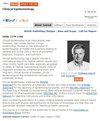紧急呼叫救护车与全科医生请求救护车--患者死亡率、疾病严重程度和模式
IF 3.2
2区 医学
Q1 PUBLIC, ENVIRONMENTAL & OCCUPATIONAL HEALTH
引用次数: 0
摘要
导言:在有关急诊需求增加的研究中,全科医生为初级保健患者申请救护车(GP-requested)的情况经常被忽略,但这可能是一个庞大的患者群体。我们旨在评估全科医生请求的救护车患者与紧急呼叫救护车患者的急性病严重程度、重症监护室(ICU)入院情况、诊断模式(包括合并症)和死亡率。我们的假设是,紧急呼叫患者的健康问题比全科医生请求的救护车患者更严重。方法:对北丹麦地区的救护车患者进行基于人群的历史性队列研究,时间为2016-2020年。医院联系数据(包括诊断、救护车数据、生命体征和生命状态)与每位患者的唯一识别码相关联。主要结果是 1 天、7 天和 30 天内的死亡率。次要结果是疾病严重程度(以修改后的全国早期预警评分(NEWS2)表示)和入住重症监护室情况。对入院情况和医院诊断模式(包括合并症)进行了描述和比较:我们纳入了 255487 名患者。与急诊呼叫患者相比,全科医生请求的患者(N = 119,361, 46.7%)年龄更大(中位年龄 [IQR] 73 [58- 83] 对 61 [37- 76]),中度/重度合并症患者更多(11.9%, N = 13,806 对 4.9%, N = 6145)。院前 mNEWS2 中位数得分在全科医生要求的患者中较低。两组患者中,66岁以上患者的mNEWS2得分最高。全科医生申请患者的 30 天死亡率(9.0% (95% CI: 8.8- 9.2), N = 8996)高于急诊呼叫患者(5.2% (95% CI: 5.1- 5.4), N = 6727)。循环系统疾病(12.0%,11,695/97,112)和呼吸系统疾病(11.6%,11,219/97,112)在全科医生申请患者中的发病率高于急诊呼叫患者((10.7%,12,640/118,102)和(5.8%,6858/118,102))。在紧急呼叫组中,死亡人数最多的健康问题是 "循环系统疾病",在全科医生请求组中,死亡人数最多的健康问题是 "其他因素",其次是 "呼吸系统疾病":全科医生请求的患者占急诊医疗服务量的近一半,他们年龄更大、合并症更多,病情严重,急性期更长,30 天死亡率高于急诊呼叫患者。 关键词:急诊医疗服务;死亡率;诊断;预警评分;下班后护理;初级医疗保健;全科医生本文章由计算机程序翻译,如有差异,请以英文原文为准。
Emergency Call versus General Practitioner Requested Ambulances – Patient Mortality, Disease Severity and Pattern
Introduction: Ambulance requests by general practitioners for primary care patients (GP-requested) are often omitted in studies on increased demand within emergency care but may comprise a substantial patient group. We aimed to assess acute severity, intensive care unit (ICU) admission, and diagnostic pattern, including comorbidity, and mortality among GP-requested ambulance patients, compared to emergency call ambulance patients. Our hypothesis was that emergency call patients had more severe health issues than GP-requested ambulance patients.
Methods: Historic population-based cohort study of ambulance patients in the North Denmark Region, 2016– 2020. Hospital contact data including diagnoses, ambulance data, vital signs and vital status was linked using each patient’s unique identification number. Primary outcome measure was mortality within 1, 7, and 30 days. Secondary outcomes were disease severity expressed as modified National Early Warning Score (NEWS2), and ICU admission. Admission status and hospital diagnostic pattern, including comorbidity were described and compared.
Results: We included 255,487 patients. GP-requested patients (N = 119,361, 46.7%) were older (median years [IQR] 73 [58– 83] versus 61 [37– 76]) and more had moderate/severe comorbidity (11.9%, N = 13,806 versus 4.9%, N = 6145) than the emergency call patients. Prehospital mNEWS2 median scores were lower for GP-requested patients. For both groups, mNEWS2 was highest among patients aged 66+. GP-requested patients had higher 30-day mortality (9.0% (95% CI: 8.8– 9.2), N = 8996) than emergency call patients (5.2% (95% CI: 5.1– 5.4), N = 6727). Circulatory (12.0%, 11,695/97,112) and respiratory diseases (11.6%, 11,219/97,112) were more frequent among GP-requested patients than emergency call patients ((10.7%, 12,640/118,102) and (5.8%, 6858/118,102)). The highest number of deaths was found for health issues ‘circulatory diseases’ in the emergency call group and ‘other factors’ followed by “respiratory diseases” in the GP-requested group.
Conclusion: GP-requested patients constituted nearly half of the EMS volume, they were older, with more comorbidity, had serious conditions with substantial acute severity, and a higher 30-day mortality than emergency call patients.
Keywords: emergency medical services, mortality, diagnoses, early warning scores, after-hours care, primary healthcare, general practitioners
Methods: Historic population-based cohort study of ambulance patients in the North Denmark Region, 2016– 2020. Hospital contact data including diagnoses, ambulance data, vital signs and vital status was linked using each patient’s unique identification number. Primary outcome measure was mortality within 1, 7, and 30 days. Secondary outcomes were disease severity expressed as modified National Early Warning Score (NEWS2), and ICU admission. Admission status and hospital diagnostic pattern, including comorbidity were described and compared.
Results: We included 255,487 patients. GP-requested patients (N = 119,361, 46.7%) were older (median years [IQR] 73 [58– 83] versus 61 [37– 76]) and more had moderate/severe comorbidity (11.9%, N = 13,806 versus 4.9%, N = 6145) than the emergency call patients. Prehospital mNEWS2 median scores were lower for GP-requested patients. For both groups, mNEWS2 was highest among patients aged 66+. GP-requested patients had higher 30-day mortality (9.0% (95% CI: 8.8– 9.2), N = 8996) than emergency call patients (5.2% (95% CI: 5.1– 5.4), N = 6727). Circulatory (12.0%, 11,695/97,112) and respiratory diseases (11.6%, 11,219/97,112) were more frequent among GP-requested patients than emergency call patients ((10.7%, 12,640/118,102) and (5.8%, 6858/118,102)). The highest number of deaths was found for health issues ‘circulatory diseases’ in the emergency call group and ‘other factors’ followed by “respiratory diseases” in the GP-requested group.
Conclusion: GP-requested patients constituted nearly half of the EMS volume, they were older, with more comorbidity, had serious conditions with substantial acute severity, and a higher 30-day mortality than emergency call patients.
Keywords: emergency medical services, mortality, diagnoses, early warning scores, after-hours care, primary healthcare, general practitioners
求助全文
通过发布文献求助,成功后即可免费获取论文全文。
去求助
来源期刊

Clinical Epidemiology
Medicine-Epidemiology
CiteScore
6.30
自引率
5.10%
发文量
169
审稿时长
16 weeks
期刊介绍:
Clinical Epidemiology is an international, peer reviewed, open access journal. Clinical Epidemiology focuses on the application of epidemiological principles and questions relating to patients and clinical care in terms of prevention, diagnosis, prognosis, and treatment.
Clinical Epidemiology welcomes papers covering these topics in form of original research and systematic reviews.
Clinical Epidemiology has a special interest in international electronic medical patient records and other routine health care data, especially as applied to safety of medical interventions, clinical utility of diagnostic procedures, understanding short- and long-term clinical course of diseases, clinical epidemiological and biostatistical methods, and systematic reviews.
When considering submission of a paper utilizing publicly-available data, authors should ensure that such studies add significantly to the body of knowledge and that they use appropriate validated methods for identifying health outcomes.
The journal has launched special series describing existing data sources for clinical epidemiology, international health care systems and validation studies of algorithms based on databases and registries.
 求助内容:
求助内容: 应助结果提醒方式:
应助结果提醒方式:


